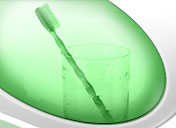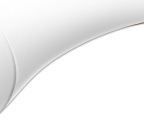Gum disease describes swelling,
soreness or infection of the tissues supporting the teeth. There
are two main forms of gum disease: gingivitis and periodontal
disease.
|
|
|
What is gingivitis?
|
Gingivitis means inflammation of the
gums. This is when the gums around the teeth become very red and
swollen. Often the swollen gums bleed when they are brushed during
cleaning.
|
|
|
What is periodontal disease?
|
Long-standing gingivitis can turn into
periodontal disease. There are a number of types of periodontal
disease and they all affect the tissues supporting the teeth. As
the disease gets worse the bone anchoring the teeth in the jaw is
lost, making the teeth loose. If this is not treated, the teeth
may eventually fall out.
|
|
|
Am I likely to suffer from gum disease?
|
Probably. Most people suffer from some
form of gum disease, and it is the major cause of tooth loss in
adults. However, the disease develops very slowly in most people,
and it can be slowed down to a rate that should allow you to keep
most of your teeth for life.
|
|
|
What is the cause of gum disease?
|
All gum disease is caused by plaque.
Plaque is a film of bacteria which forms on the surface of the
teeth and gums every day. Many of the bacteria in plaque are
completely harmless, but there are some that have been shown to be
the main cause of gum disease. To prevent and treat gum disease,
you need to make sure you remove all the plaque from your teeth
every day. This is done by brushing and flossing.
|
|
|
How will smoking affect my gums and teeth?
|
Smoking can also lead to gum disease.
Patients who smoke are more likely to produce bacterial plaque,
which leads to gum disease. The gums are affected because smoking
causes a lack of oxygen in the bloodstream, so the infected gums
fail to heal. Smoking causes people to have more dental plaque and
for gum disease to progress more rapidly than in non-smokers. Gum
disease still remains the most common cause of tooth loss in
adults.
|
|
|
What happens if gum disease is not treated?
|
Unfortunately, gum disease progresses
painlessly on the whole so that you do notice the damage it is
doing. However, the bacteria are sometimes more active and this
makes your gums sore. This can lead to gum abscesses, and pus may
ooze from around the teeth. Over a number of years, the bone
supporting the teeth can be lost. If the disease is left untreated
for a long time, treatment can become more difficult.
|
|
|
How do I know if I have gum disease?
|
The first sign is blood on the
toothbrush or in the rinsing water when you clean your teeth. Your
gums may also bleed when you are eating, leaving a bad taste in
your mouth. Your breath may also become unpleasant.
|
|
|
What do I do if I think I have gum disease?
|
The first thing to do is visit your
dentist for a thorough check-up of your teeth and gums. The
dentist can measure the �cuff� of gum around each tooth to see
if there is any sign that periodontal disease has started. X-rays
may also be needed to see the amount of bone that has been lost.
This assessment is very important, so the correct treatment can be
prescribed for you.
|
|
|
What treatments are needed?
|
Your dentist will usually give your
teeth a thorough clean. You�ll also be shown how to remove
plaque successfully yourself, cleaning all surfaces of your teeth
thoroughly and effectively. This may take a number of sessions
with the dentist or hygienist.
|
|
|
What else may be needed?
|
Once your teeth are clean, your
dentist may decide to carry out further cleaning of the roots of
the teeth, to make sure that the last pockets of bacteria are
removed. You�ll probably need the treatment area to be numbered
before anything is done. Afterwards, you may feel some discomfort
for up to 48 hours.
|
|
|
Once I have had periodontal disease, can I get it
again?
|
The periodontal diseases are never
cured. But as long as you keep up the home care you have been
taught, any further loss of bone will be very slow and it may stop
altogether. However, you must make sure you remove plaque every
day, and go for regular check ups by the dentist and hygienist.
|
|



